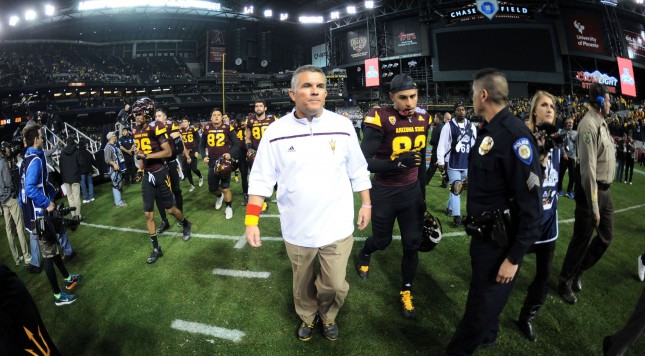College football is a billion-dollar business.
College football head coaches at Power 5 schools — with very few exceptions — receive seven-figure compensation levels each year.
There is absolutely no excuse for kicking an extra point when leading by five with under five minutes left in regulation, but Todd Graham of Arizona State did exactly that in the Cactus Bowl against West Virginia.
Hey, we’re human beings. We’re imperfect. We make mistakes… but not like that.
How could no one with a headset on the Arizona State sideline or in the press box override Graham and convey to him the urgency of the situation — enough, at any rate, to make him change his mind? Let’s emphasize this one detail: The late stage of the game meant that even if Arizona State had to take a five-yard delay-of-game penalty in order to go for two from the 8-yard line, it was worth it. There was almost zero value in kicking a PAT at that time (the only value being found in gaining a tie just in case West Virginia missed a PAT after a subsequent touchdown). Going for two from the 8 would have been the right thing to do. Again, no one prevailed upon Graham to adjust his decision.
That’s a spectacular blunder, as large a coaching mistake as any you’ll ever see.
If that was the only noticeable mistake Graham made, it would have been enough to make his performance average at best, EVEN if he had coached brilliantly the rest of the game.
Sadly for Graham, he coached poorly throughout the Cactus Bowl, earning the worst grade out of all 80 coaches in the 40 bowls just played.
*
Todd Graham — he of the “high-octane” offense and all the aggressiveness that label is supposed to suggest — produced what will very likely remain the most appalling coaching performance of 2016 (the calendar year, not the season). As horrible as his PAT decision was, he made three other fundamental mistakes which a billion-dollar industry should never tolerate.
Graham kicked a 19-yard field goal in a game which had all the makings of a shootout (and did in fact become one). Coaches need to have extremely compelling reasons for kicking 19-yard field goals. If you lead by six points with 2:30 left in regulation, yes, you can and should kick a field goal on fourth and goal from the 2. Only a small number of similar scenarios should ever justify one of football’s most timid coaching decisions. Graham did not face such a scenario when making that choice on Saturday night in Phoenix.
Graham also blew a timeout because he wanted to kick an onside kick and didn’t have the alignment he wanted from his kickoff unit. That’s the kind of timeout which is acceptable in the first half, when the consequences aren’t as substantial. However, there’s no excuse for using a timeout in such a manner in the second half. ASU’s lack of a timeout hurt the Sun Devils in the endgame phase — had they found a way to stop West Virginia on the game’s penultimate series of downs, their lack of a timeout would have given them a lot less time in which to drive for a game-winning field goal.
Amazingly, this STILL wasn’t the end of Graham’s parade of major mistakes.
Inside the final 1:20 of regulation, Graham watched over 10 seconds tick off the clock after a West Virginia running play on first down. Everyone inside Chase Field understood what Graham was apparently doing — he was saving the two timeouts he had left for West Virginia’s second- and third-down runs. If you have two timeouts, there’s no absolute, set-in-stone rule which says you have to use your timeouts after first and second down. It’s perfectly reasonable to use them after second and third down — it all ends up the same if you have only two timeouts and not all three.
However, once the clock melted off those 10-plus seconds, Graham did indeed have to withhold his timeout, saving it after West Virginia’s next (second-down) play. Everyone in the stadium also knew that. Such a point of understanding was as elemental as going for two when up five with 4:56 left in the fourth quarter.
Graham called timeout.
A cascade of well-deserved boos flowed from Arizona State fans, who had to wonder if their coach had placed a bet on this game (ASU did cover the spread in some outlets), was drunk, or both. Seriously — this was the kind of coaching performance which makes a casual observer wonder if the outcome was fixed. It wasn’t, but if any reports ever surfaced that it was, would anyone be that shocked? The markings exist(ed).
Yes, Todd Graham’s coaching performance was that bad. Not one, not two, not three (sorry, LeBron), but FOUR LARGE-SCALE BLUNDERS all occurred in the same game.
It’s not the kind of thing which will inspire confidence in Arizona State next season, with USC, UCLA and Arizona all competing against the Sun Devils in the Pac-12 South.
We all make mistakes as human beings… but the kinds of mistakes Todd Graham made in the Cactus Bowl have no place in a billion-dollar industry.
If Arizona State’s 2016 season spirals out of control, more than a few observers will point to the 2016 Cactus Bowl as proof that Graham should be on the hot seat entering 2017.

